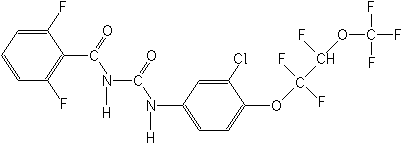-
Common NameNovaluron
-
中文通用名氟酰脲
-
IUPAC(RS)-1-[3-chloro-4-(1,1,2-trifluoro-2-trifluoromethoxyethoxy)phenyl]-3-(2,6-difluorobenzoyl)urea
-
CASN-[[[3-chloro-4-[1,1,2-trifluoro-2-(trifluoromethoxy)ethoxy]phenyl]amino]carbonyl]-2,6-difluorobenzamide
-
CAS No.116714-46-6
-
Molecular FormulaC17H9ClF8N2O4
-
Molecular Structure
-
Category
-
ActivityInsecticide.Novaluron is a chitin synthase inhibitor active against larvae of the orders Coleoptera, Homoptera, Diptera and Lepidoptera. Chitin is only actively synthesised by the immature stages of insects resulting in good selectivity to adults of beneficial species. Novaluron is strictly a contact insecticide; it has no systemic activity. It is mainly a stomach poison and has some ovicidal activity.
A further mode of action for novaluron was reported in 2002 (BCPC) - it was found to be an inhibitor of acetylcholinesterase in B-biotype Bemisia tabaci, similar to buprofezin, another chitin synthesis inhibitor. This could indicate that there is cross-resistance between novaluron and buprofezin. No cross-resistance has been noted between novaluron and other benzoyl urea IGR’s used against Bemisia tabaci, Spodoptera spp and Leptinotarsa.
In field trials on cotton and vegetables, novaluron has shown residual activity lasting at least 15 days.
Novaluron is reported to damage the leaves of poinsettias (chlorotic streaking or blotching); Crompton does not recommend its use on this ornamental species.
In Ontario (Canada), novaluron is under evaluation by Crompton and the University of Guelph for control of Colorado beetle on potato; this pest is rapidly developing resistance to the currently used insecticides. Initial results (2002) were promising with novaluron maintaining the populations of 3rd and 4th instar larvae at the level of the industry reference (imidacloprid).
In field and laboratory trials, the product was found to be safe to major beneficial insects and can be used as a part of the IPM programme. In order to preserve its effectiveness, use of the product should be restricted to two applications per season in alternation with other products. -
CropUseCropUses:
apples, aubergines, cabbage, Chinese cabbage, citrus, cotton, eggs, forestry, maize, meat, milk, ornamentals, pears, pome fruits, potatoes, stone fruits, tobacco, tomatoes, tree fruits, turf, vegetables
Vegetables: 25-50 g ai/ha
Pears/apples: 5-10 g ai/hl (US recomm. Rates1.1-4.4 lb/acre Diamond 7.5% WG)
Potatoes: 15-50 g ai/ha (US recommended rates 9-12 oz/acre Rimon 10% EC)
Cotton: 10-50 g ai/ha (US recommended rates 6-14 oz/acre Diamond 10% EC)
-
PremixBifenthrin+Novaluron
Type
AI concn
Emulsifiable concentrate (EC)
10% (w/v)
Suspension concentrate (SC)
10% (w/v)
Water dispersible granule (WG)
7.5% (w/w)
-
Physical PropertiesMolecular weight:492.7g/mol; Density:1.56 (22℃); Composition:Tech. is 96%. Melting point:176.5-178℃; Flash point:202℃ (closed cup) (EEC A9, ASTM E502-84 and ASTM D 32786-82); Vapour pressure:1.6 × 10-2 mPa (25℃) (OECD 104, EEC A8); Partition coefficient(n-octanol and water):logP = 4.3 (OECD 107, EEC A4); Solubility:In water 53.07 mg/l (25 ℃) (OECD 105, EEC A6). Soluble in organic solvents.;
-
ToxicologyOral:Acute oral LD50 for rats >5000 mg/ kg. Percutaneous:Acute percutaneous LD50 for rats >2000 mg/kg. Not irritating to eyes and skin (rabbits). Not a skin sensitiser (guinea pigs). Inhalation: LC50 (4 h) for rats >5.15 mg/l air. ADI:(US) 0.02 mg/ kg b.w.
-
Environmental ProfileEcotoxicology:
Algae:Non-toxic.Bees: LC50 (oral and contact) >100 mg/bee.Birds:Acute oral LD50 for mallard ducks >2000 mg/kg. Dietary LC50 (5 d) for bobwhite quail and mallard ducks >5200 ppm.Daphnia: LC50 (48 h) 58 mg/l.Fish: LC50 (96 h) for rainbow trout and bluegill sunfish >1 mg/l.Worms:Non-toxic.Other beneficial spp.:Non-toxic.
Environmental fate:
Animals:The major route of elimination was via the faeces.Soil: DT50 (aerobic) 68.5-75.5 d (sandy loam and loamy sand soils). Strongly adsorbed to soil, Koc 6650-11 813.Plant:In potatoes and apples, a.i. remains unchanged. -
Transport InformationSignal Word:CAUTION; Hazard Class:III(Slightly hazardous)
Porduct NewsMore
Adama got use extension for Voraz insecticide in Brazil
Australia to approve Adama’s insecticide Cormoran
Louisiana approved BASF’s Trelona ATBS termite baiting and monitoring program
India CIBRC 351th meeting approved 7 pesticide technical registrations
Metamitron EPTC Diafenthiuron Novaluron Buprofezin Cymoxanil Propiconazole
Related CompaniesMore
Country: China
Flusilazole Triadimefon Pyraclostrobin Trifloxystrobin Imidacloprid Niclosamide Novaluron Clomazone Bentazone Paclobutrazol Tebuconazole Flutriafol Lufenuron Isoxadifen-ethyl
Jiangsu Flag Chemical Industry Co.,Ltd
Country: China
Fluazinam Lufenuron Isoxaflutole Imazamox Fenoxaprop-P-ethyl Cloquintocet-mexyl Carfentrazone-ethyl Imazethapyr Clodinafop-propargyl
Country: China
Clethodim Hexazinone Mesotrione Abamectin Acetamiprid Dimethoate Fipronil Imidacloprid Fosetyl-aluminium 2,4-D
Country: China
ABAMECTIN CARBOFURAN Chlorpyrifos LAMBDA-CYHALOTHRIN 2,4-D GLYPHOSATE ALUMINIUM PHOSPHIDE EDDHA-Fe 6% ZINC SULFATE HEPTAHYDRATE
Weihai Hanfu Biological and Chemical Medication Co., Ltd.
Country: China
2,4-D Imidacloprid Acetamiprid Fipronil Emamectin benzoate Lufenuron Ethoprophos Triflumuron Polyoxins Kasugamycin

 0
0 Subscribe
Subscribe
